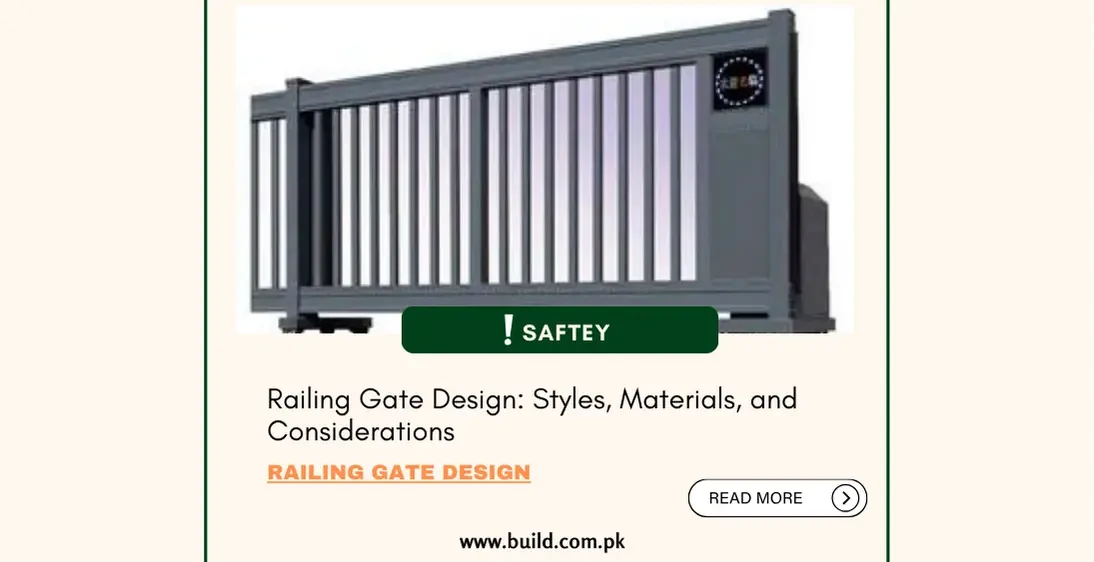Railing Gate Design: Styles, Materials, and Considerations

Introduction:
Railing
gates serve both practical and aesthetic purposes in architectural and interior
desin. They provide security, define boundaries, and enhance the overall look
of a property. Whether used for balconies, staircases, decks, or entrances,
railing gates can be customized to match the style and theme of any space.
Styles of Railing Gates
Traditional Railing Gates:
Traditional
railing gates feature classic designs with ornamental details such as scrolls,
twists, or intricate patterns. They are often made from wrought iron or steel
and are ideal for adding a touch of elegance to historic or traditional-style
homes.
Modern Railing Gates:
Modern
railing gates emphasize simplicity and clean lines. They are typically
constructed from materials like stainless steel or aluminum, offering a sleek
and contemporary look. Modern designs often prioritize functionality and can
complement minimalist or industrial-style interiors.
Glass Railing Gates:
Glass
railing gates create a sense of openness and transparency. They are popular in
modern architecture and offer unobstructed views while maintaining safety and
security. Glass gates are often paired with metal or wooden frames for added
durability and style.
Custom Railing Gates:
Custom
railing gates allow for artistic expression and personalization. These gates
can incorporate unique shapes, patterns, or materials to create a one-of-a-kind
design statement. Custom gates are perfect for homeowners looking to showcase
their creativity.
Materials for Railing Gates
Wrought Iron:
Wrought
iron is a timeless and durable material commonly used for traditional railing
gates. It can be molded into intricate designs and is resistant to corrosion
when properly maintained. Wrought iron gates often require periodic painting or
coating to protect against rust.
Steel:
Steel
railing gates offer strength and versatility. They can be fabricated in various
styles and are suitable for both traditional and modern designs. Steel gates
can be powder-coated to enhance durability and resist weathering.
Aluminum:
Aluminum
is lightweight: yet sturdy, making it an excellent choice for railing gates. It
is resistat to rust and corrosion, making it ideal for outdoor applications.
Aluminum gates are available in a wide range of colors and finishes.
Glass:
Glass
railing gates provide a contemporary and elegant appearance. Tempered glass is
used for safety and durability, and it can be combined with metal or wooden
frames to create a striking visual contrast. Glass gates require regular cleaning
to maintain transparency.
Considerations for Railing Gate Design
- Building Codes: Ensure that your railing gate complies with local building codes and safety standards. Pay attention to height requirements, spacing between balusters or panels, and child safety guidelines.
- Functionality and Accssibility: Consider the intended use of the railing gate. Ensure that it opens and closes smoothly, especially for gates used for entryways or staircases. Consider adding automatic or self-closing mechanisms for convenience.
- Durability and Maintenance: Choose materials that can withstand weather exposure and require minimal maintenance. Regular cleaning and occasional inspections will help prolong the lifespan of your railing gate.
- Aesthetics and Design Harmony: Coordinate the design of the railing g:ate with the overall style of your home or building. Choose colors, finishes, and decorative elements that complement existing architectural features.
- Budget and Installation: Factor in the cost of materials, fabrication, and installation when planning your railing gate project. Obtain quotes from reputable contractors and consider long-term value when making budget decisions.
Installation Tips for Railing Gates
- Hire Professional Installers: Ensure that your railing gate is installed by experienced professionals to ensure safety and structural integrity. Professional installers can also assist with design considerations and material selection.
- Proper Anchoring and Support: Ensure that railing gates are securely anchored to structural supports, such as walls, columns, or posts. Use high-quality fasteners and hardware to withstand daily use and environmental conditions.
- Regular Maintenance and Inspections: Schedule regular maintenance to inspect and clea your railing gate. Check for signs of wear, loose components, or rust, and address any issues promptly to prevent further damage.
Conclusion:
Designing a railing gate involves a blend of creativity, functionality, and practical considerations. By selecting the right style, materials, and installation methods, you can create a beautiful and durable railing gate that enhances the safety and aesthetics of your property. Consider the uique characteristics of your space and consult with professionals to bring your railing gate design ideas to life.









